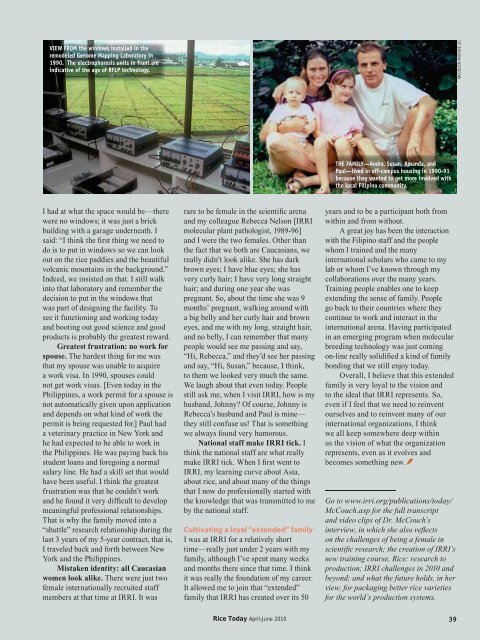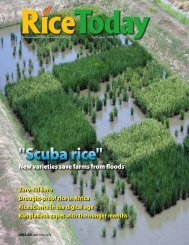A sunburned grain Stamps of approval Pockets of gold in ... - adron.sr
A sunburned grain Stamps of approval Pockets of gold in ... - adron.sr
A sunburned grain Stamps of approval Pockets of gold in ... - adron.sr
You also want an ePaper? Increase the reach of your titles
YUMPU automatically turns print PDFs into web optimized ePapers that Google loves.
VIEW FROM the w<strong>in</strong>dows <strong>in</strong>stalled <strong>in</strong> theremodeled Genome Mapp<strong>in</strong>g Laboratory <strong>in</strong>1990. The electrophoresis units <strong>in</strong> front are<strong>in</strong>dicative <strong>of</strong> the age <strong>of</strong> RFLP technology.MCCOUCH ARCHIVE (2)THE FAMILY—Andre, Susan, Amanda, andPaul—lived <strong>in</strong> <strong>of</strong>f-campus hous<strong>in</strong>g <strong>in</strong> 1990-91because they wanted to get more <strong>in</strong>volved withthe local Filip<strong>in</strong>o community.I had at what the space would be—therewere no w<strong>in</strong>dows; it was just a brickbuild<strong>in</strong>g with a garage underneath. Isaid: “I th<strong>in</strong>k the first th<strong>in</strong>g we need todo is to put <strong>in</strong> w<strong>in</strong>dows so we can lookout on the rice paddies and the beautifulvolcanic mounta<strong>in</strong>s <strong>in</strong> the background.”Indeed, we <strong>in</strong>sisted on that. I still walk<strong>in</strong>to that laboratory and remember thedecision to put <strong>in</strong> the w<strong>in</strong>dows thatwas part <strong>of</strong> design<strong>in</strong>g the facility. Tosee it function<strong>in</strong>g and work<strong>in</strong>g todayand boot<strong>in</strong>g out good science and goodproducts is probably the greatest reward.Greatest frustration: no work forspouse. The hardest th<strong>in</strong>g for me wasthat my spouse was unable to acquirea work visa. In 1990, spouses couldnot get work visas. [Even today <strong>in</strong> thePhilipp<strong>in</strong>es, a work permit for a spouse isnot automatically given upon applicationand depends on what k<strong>in</strong>d <strong>of</strong> work thepermit is be<strong>in</strong>g requested for.] Paul hada veter<strong>in</strong>ary practice <strong>in</strong> New York andhe had expected to be able to work <strong>in</strong>the Philipp<strong>in</strong>es. He was pay<strong>in</strong>g back hisstudent loans and forego<strong>in</strong>g a normalsalary l<strong>in</strong>e. He had a skill set that wouldhave been useful. I th<strong>in</strong>k the greatestfrustration was that he couldn’t workand he found it very difficult to developmean<strong>in</strong>gful pr<strong>of</strong>essional relationships.That is why the family moved <strong>in</strong>to a“shuttle” research relationship dur<strong>in</strong>g thelast 3 years <strong>of</strong> my 5-year contract, that is,I traveled back and forth between NewYork and the Philipp<strong>in</strong>es.Mistaken identity: all Caucasianwomen look alike. There were just tw<strong>of</strong>emale <strong>in</strong>ternationally recruited staffmembers at that time at IRRI. It wa<strong>sr</strong>are to be female <strong>in</strong> the scientific arenaand my colleague Rebecca Nelson [IRRImolecular plant pathologist, 1989-96]and I were the two females. Other thanthe fact that we both are Caucasians, wereally didn’t look alike. She has darkbrown eyes; I have blue eyes; she hasvery curly hair; I have very long straighthair; and dur<strong>in</strong>g one year she waspregnant. So, about the time she was 9months’ pregnant, walk<strong>in</strong>g around witha big belly and her curly hair and browneyes, and me with my long, straight hair,and no belly, I can remember that manypeople would see me pass<strong>in</strong>g and say,“Hi, Rebecca,” and they’d see her pass<strong>in</strong>gand say, “Hi, Susan,” because, I th<strong>in</strong>k,to them we looked very much the same.We laugh about that even today. Peoplestill ask me, when I visit IRRI, how is myhusband, Johnny? Of course, Johnny isRebecca’s husband and Paul is m<strong>in</strong>e—they still confuse us! That is someth<strong>in</strong>gwe always found very humorous.National staff make IRRI tick. Ith<strong>in</strong>k the national staff are what reallymake IRRI tick. When I first went toIRRI, my learn<strong>in</strong>g curve about Asia,about rice, and about many <strong>of</strong> the th<strong>in</strong>gsthat I now do pr<strong>of</strong>essionally started withthe knowledge that was transmitted to meby the national staff.Cultivat<strong>in</strong>g a loyal “extended” familyI was at IRRI for a relatively shorttime—really just under 2 years with myfamily, although I’ve spent many weeksand months there s<strong>in</strong>ce that time. I th<strong>in</strong>kit was really the foundation <strong>of</strong> my career.It allowed me to jo<strong>in</strong> that “extended”family that IRRI has created over its 50years and to be a participant both fromwith<strong>in</strong> and from without.A great joy has been the <strong>in</strong>teractionwith the Filip<strong>in</strong>o staff and the peoplewhom I tra<strong>in</strong>ed and the many<strong>in</strong>ternational scholars who came to mylab or whom I’ve known through mycollaborations over the many years.Tra<strong>in</strong><strong>in</strong>g people enables one to keepextend<strong>in</strong>g the sense <strong>of</strong> family. Peoplego back to their countries where theycont<strong>in</strong>ue to work and <strong>in</strong>teract <strong>in</strong> the<strong>in</strong>ternational arena. Hav<strong>in</strong>g participated<strong>in</strong> an emerg<strong>in</strong>g program when molecularbreed<strong>in</strong>g technology was just com<strong>in</strong>gon-l<strong>in</strong>e really solidified a k<strong>in</strong>d <strong>of</strong> familybond<strong>in</strong>g that we still enjoy today.Overall, I believe that this extendedfamily is very loyal to the vision andto the ideal that IRRI represents. So,even if I feel that we need to re<strong>in</strong>ventourselves and to re<strong>in</strong>vent many <strong>of</strong> our<strong>in</strong>ternational organizations, I th<strong>in</strong>kwe all keep somewhere deep with<strong>in</strong>us the vision <strong>of</strong> what the organizationrepresents, even as it evolves andbecomes someth<strong>in</strong>g new.Go to www.irri.org/publications/today/McCouch.asp for the full transcriptand video clips <strong>of</strong> Dr. McCouch’s<strong>in</strong>terview, <strong>in</strong> which she also refl ectson the challenges <strong>of</strong> be<strong>in</strong>g a female <strong>in</strong>scientifi c research; the creation <strong>of</strong> IRRI’snew tra<strong>in</strong><strong>in</strong>g course, Rice: research toproduction; IRRI challenges <strong>in</strong> 2010 andbeyond; and what the future holds, <strong>in</strong> herview, for packag<strong>in</strong>g better rice varietiesfor the world’s production systems.Rice Today April-June 201039

















